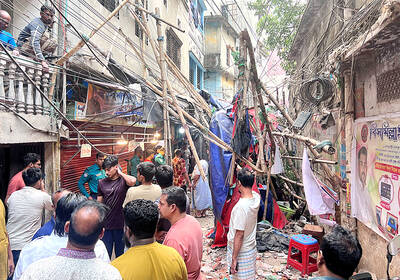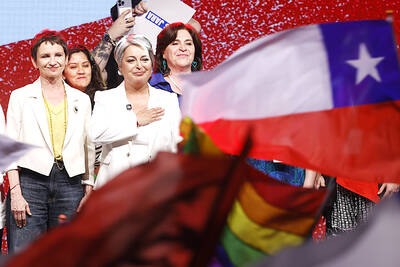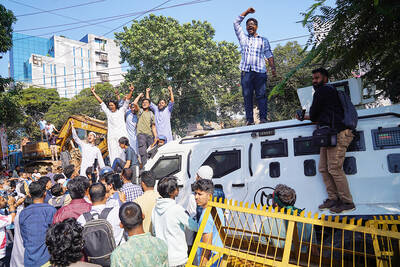The chilling sights and sounds of war fill newspapers and television screens worldwide, but war itself is in decline, researchers report.
In fact, the number killed in battle has fallen to its lowest point in the post-World War II period, dipping below 20,000 a year by one measure. Peacemaking missions, meantime, are growing in number.
"International engagement is blossoming," said American researcher Monty Marshall. "There's been an enormous amount of activity to try to end these conflicts."
For months the battle reports and casualty tolls from Iraq and Afghanistan have put war in the headlines, but Swedish and Canadian nongovernmental groups tracking armed conflict globally find a general decline in numbers from peaks in the 1990s.
The authoritative Stockholm International Peace Research Institute, in a 2004 Yearbook report obtained by reporters in advance of publication, says 19 major armed conflicts were under way worldwide last year, a sharp drop from 33 wars counted in 1991. The Canadian organization Project Ploughshares, using broader criteria to define armed conflict, says in its new annual report that the number of conflicts declined to 36 last year, from a peak of 44 in 1995.
The Stockholm institute counts continuing wars that have produced 1,000 or more battle-related deaths in any single year. Project Ploughshares counts any armed conflict that produces 1,000 such deaths cumulatively.
The Stockholm report, to be released next month, notes three wars were ended as of last year -- in Angola, Rwanda and Somalia -- and a fourth, the separatist war in India's Assam state, was dropped from the "major" category after casualties were recalculated.
It lists three new wars last year -- in Liberia and in Sudan's western region of Darfur, along with the US-led invasion of Iraq. These joined such long-running conflicts as the Kashmiri insurgency in India, the leftist guerrilla war in Colombia, and the separatist war in Russia's Chechnya region.
Other major armed conflicts listed by the Stockholm researchers were in Algeria, Burundi, Peru, Indonesia's Aceh province, Myanmar, Nepal, Sri Lanka, Israel and Turkey. Their list also includes the US war on al-Qaeda, mainly in Afghanistan; the unresolved India-Pakistan conflict, and two insurgencies in the Philippines.
"Not only are the numbers declining, but the intensity" -- the bloodshed in each conflict -- "is declining," said Marshall, founder of a University of Maryland program studying political violence.
The continuing wars in Algeria, Chechnya and Turkey are among those that have subsided into low-intensity conflicts. At Canada's University of British Columbia, scholars at the Human Security Center are quantifying this by tackling the difficult task of calculating war casualties worldwide for their Human Security Report, to be released late last year.
A collaboration with Sweden's Uppsala University, that report will conservatively estimate battle-related deaths worldwide at 15,000 in 2002 and, because of the Iraq war, rising to 20,000 last year. Those estimates are down from annual tolls ranging from 40,000 to 100,000 in the 1990s, a time of major costly conflicts in such places as the former Zaire and southern Sudan, and from a post-World War II peak of 700,000 in 1951.
The Canadian center's director, Andrew Mack, said the figures don't include deaths from war-induced starvation and disease, deaths from ethnic conflicts not involving states, or unopposed massacres, such as in Rwanda in 1994.
Why the declines? Peace researchers point to crosscurrents of global events.
For one thing, the Cold War's end and breakup of the Soviet Union in 1989 to 1991 ignited civil and separatist wars in the old East bloc and elsewhere, as the superpowers' hands were lifted in places where they'd long held allies in check. Those wars surged in the early 1990s.
"The decline over the past decade measures the move away from that unusual period," said Ernie Regehr, director of Project Ploughshares.
At the same time, however, the US-Russian thaw worked against war as well, scholars said, by removing superpower support in "proxy wars," as in Ethiopia, Mozambique and Cambodia. With dwindling money and arms, warmakers had to seek peace.
The UN and regional bodies, meanwhile, were mobilizing for more effective peacemaking worldwide.
"The end of the Cold War liberated the UN" -- historically paralyzed by US-Soviet antagonism -- "to do what its founders had originally intended and more," Mack said.
Last year alone, from Ivory Coast to the Solomon Islands, 14 multilateral missions were launched to protect or reinforce peace settlements, the highest number of new peace missions begun in a single year since the Cold War, the Stockholm institute will report.

DISASTER: The Bangladesh Meteorological Department recorded a magnitude 5.7 and tremors reached as far as Kolkata, India, more than 300km away from the epicenter A powerful earthquake struck Bangladesh yesterday outside the crowded capital, Dhaka, killing at least five people and injuring about a hundred, the government said. The magnitude 5.5 quake struck at 10:38am near Narsingdi, Bangladesh, about 33km from Dhaka, the US Geological Survey (USGS) said. The earthquake sparked fear and chaos with many in the Muslim-majority nation of 170 million people at home on their day off. AFP reporters in Dhaka said they saw people weeping in the streets while others appeared shocked. Bangladesh Interim Leader Muhammad Yunus expressed his “deep shock and sorrow over the news of casualties in various districts.” At least five people,

LEFT AND RIGHT: Battling anti-incumbent, anticommunist sentiment, Jeanette Jara had a precarious lead over far-right Jose Antonio Kast as they look to the Dec. 14 run Leftist candidate Jeannette Jara and far-right leader Jose Antonio Kast are to go head-to-head in Chile’s presidential runoff after topping Sunday’s first round of voting in an election dominated by fears of violent crime. With 99 percent of the results counted, Jara, a 51-year-old communist running on behalf of an eight-party coalition, won 26.85 percent, compared with 23.93 percent for Kast, the Servel electoral service said. The election was dominated by deep concern over a surge in murders, kidnappings and extortion widely blamed on foreign crime gangs. Kast, 59, has vowed to build walls, fences and trenches along Chile’s border with Bolivia to

DEATH SENTENCE: The ousted leader said she was willing to attend a fresh trial outside Bangladesh where the ruling would not be a ‘foregone conclusion’ Bangladesh’s fugitive former prime minister Sheikh Hasina yesterday called the guilty verdict and death sentence in her crimes against humanity trial “biased and politically motivated.” Hasina, 78, defied court orders that she return from India to attend her trial about whether she ordered a deadly crackdown against the student-led uprising that ousted her. She was found guilty and sentenced to death earlier yesterday. “The verdicts announced against me have been made by a rigged tribunal established and presided over by an unelected government with no democratic mandate,” Hasina said in a statement issued from hiding in India. “They are biased and politically motivated,” she

It is one of the world’s most famous unsolved codes whose answer could sell for a fortune — but two US friends say they have already found the secret hidden by Kryptos. The S-shaped copper sculpture has baffled cryptography enthusiasts since its 1990 installation on the grounds of the CIA headquarters in Virginia, with three of its four messages deciphered so far. Yet K4, the final passage, has kept codebreakers scratching their heads. Sculptor Jim Sanborn, 80, has been so overwhelmed by guesses that he started charging US$50 for each response. Sanborn in August announced he would auction the 97-character solution to K4